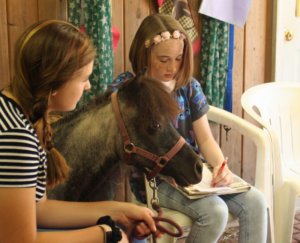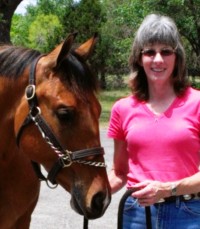Make a Resolution to Clean Hooves Daily
By Eleanor Blazer
 Over the years we develop many habits — some good and some not so good. Habits are behaviors which become automatic over years of repetitiveness. Adding a new habit to our daily routine takes effort and concentration.
Over the years we develop many habits — some good and some not so good. Habits are behaviors which become automatic over years of repetitiveness. Adding a new habit to our daily routine takes effort and concentration.
New Year’s resolutions are an attempt to either add a desirable habit or stop an undesirable habit. This year a great resolution might be: “I resolve to clean my horse’s hooves at least once a day.”
Daily cleaning removes packed mud, manure, rocks and other debris. It’s also a time to inspect for bruising, uneven wear, loose or missing shoes, and general hoof condition. Also, while cleaning the hooves watch for thrush.
Thrush is caused by a bacterium that thrives in a dark, moist, low oxygen environment (anaerobic), which perfectly describes the bottom of a hoof. Daily cleaning removes the debris that is sealing in the thrush-causing bacterium and permits early discovery.
Generally, the first symptom of thrush is a foul, putrid smell. A blackish oily discharge is the second symptom often noted. This discharge is usually first discovered in the collateral sulci — the grooves along the frog and the little triangle area at the back of the frog. If the thrush has been neglected and is in an advanced stage the frog will be tender, the horse may be lame, and the infection spreading to the heel bulbs. The frog may also appear distorted and rotted.
There can be many reasons the thrush-causing bacteria becomes active. The primary cause is usually environment — the horse is standing in filth. Constant exposure to urine and manure allows the growth of bacteria. Rarely does “clean mud” cause thrush. Horses kept in dirty stalls are more apt to get thrush than horses in a natural environment.
Other causes of thrush are inadequate diet, lack of exercise, conformational defects, unbalanced or poorly shod/trimmed hooves, and inattentive caregivers.
The first step in treating thrush is to get the horse into a dry, clean living area. Cleaning and treating the thrush will be a waste of time and money if the horse is going right back into the urine and manure-soaked stall. Treating the thrush will require trimming away the affected area. If the thrush is caught early, the educated horse owner may be able to do the minimum amount of trimming required. A farrier or veterinarian should be called if the thrush proves to be deeper than superficial, as the frog protects sensitive structures, and aggressive trimming will be detrimental to the horse.
Once the necrotic tissue has been removed, treatment continues with topical applications. Several at-home remedies used to treat thrush — bleach, copper sulfate, turpentine, pine tar and bacon grease have been shown to be problematic. Chemicals that may control the thrush also damage healthy frog and sole tissues — providing more compromised tissue for the bacteria to feed upon. Oily or greasy treatments seal the surface which prevents oxygen from getting to the affected area. The bacterium which causes thrush thrives in an anaerobic (no oxygen) environment, so we do not want to block oxygen from reaching the area.
One of the best at-home remedies is applying sugardine. Sugardine consists of one part Betadine or 10% povidone iodine to two parts white sugar. The amount of sugar can be adjusted until the mix is of a thick honey-like or peanut butter consistency. Pack it into the hoof and wrap with a breathable material — do not use plastic wrap as that will block oxygen.
There are also commercial thrush treatments on the market. Read the ingredients list to make sure they do not contain anything caustic.
As long as there are signs of thrush, daily treatment will be necessary. A couple of minutes once a day to clean hooves can save hours in the future, and your horse will thank you for your New Year’s resolution.
Copyright 2018 The Way of Horses
* Earn a Bachelor of Science Degree in Equine Studies or certification as a Professional Horse Trainer or Riding Instructor. Start your new career as a riding instructor, horse trainer, or stable manager. All courses are online. Visit www.horsecoursesonline.com for information.

Eleanor Blazer was raised training and caring for horses. She learned to ride and care for the horses her family bought and sold. Many of these horses required improved nutrition when they arrived for training. Eleanor’s experience and research has benefited both horses and horse lovers in the field of equine nutrition. An equine nutrition consultant, based in Bulverde, Texas, she keeps busy doing equine nutrition consultations, conducting seminars, and speaking to youth groups about horse care and nutrition. Eleanor is the author of the syndicated column The Way of Horses. She has more than 20 years experience helping and being a mentor to those wanting to know how to provide the very best care and nutrition for our special friend – the horse.






